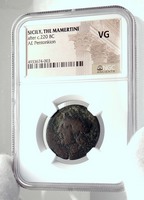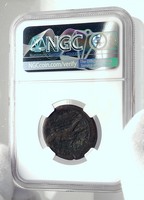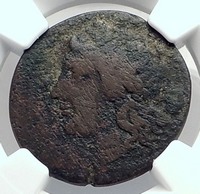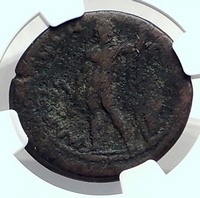You are bidding on the exact item pictured, provided with a Certificate of Authenticity and Lifetime Guarantee of Authenticity.
 In Greek and Roman mythology, Apollo, is one of the most important and diverse of the Olympian deities. The ideal of the kouros (a beardless youth), Apollo has been variously recognized as a god of light and the sun; truth and prophecy; archery; medicine and healing; music, poetry, and the arts; and more. Apollo is the son of Zeus and Leto, and has a twin sister, the chaste huntress Artemis. Apollo is known in Greek-influenced Etruscan mythology as Apulu. Apollo was worshiped in both ancient Greek and Roman religion, as well as in the modern Greco-Roman Neopaganism.
In Greek and Roman mythology, Apollo, is one of the most important and diverse of the Olympian deities. The ideal of the kouros (a beardless youth), Apollo has been variously recognized as a god of light and the sun; truth and prophecy; archery; medicine and healing; music, poetry, and the arts; and more. Apollo is the son of Zeus and Leto, and has a twin sister, the chaste huntress Artemis. Apollo is known in Greek-influenced Etruscan mythology as Apulu. Apollo was worshiped in both ancient Greek and Roman religion, as well as in the modern Greco-Roman Neopaganism.
As the patron of Delphi (Pythian Apollo), Apollo was an oracular god - the prophetic deity of the Delphic Oracle. Medicine and healing were associated with Apollo, whether through the god himself or mediated through his son Asclepius, yet Apollo was also seen as a god who could bring ill-health and deadly plague as well as one who had the ability to cure. Amongst the god's custodial charges, Apollo became associated with dominion over colonists, and as the patron defender of herds and flocks. As the leader of the Muses (Apollon Musagetes) and director of their choir, Apollo functioned as the patron god of music and poetry. Hermes created the lyre for him, and the instrument became a common attribute of Apollo. Hymns sung to Apollo were called paeans.
In Hellenistic times, especially during the third century BCE, as Apollo Helios he became identified among Greeks with Helios, god of the sun, and his sister Artemis similarly equated with Selene, goddess of the moon. In Latin texts, on the other hand, Joseph Fontenrose declared himself unable to find any conflation of Apollo with Sol among the Augustan poets of the first century, not even in the conjurations of Aeneas and Latinus in Aeneid XII (161-215). Apollo and Helios/Sol remained separate beings in literary and mythological texts until the third century CE.
Messana in Sicily founded by Greek colonists in the 8th century BCE, Messina was originally called Zancle, from the Greek: ζάγκλον meaning "scythe" because of the shape of its natural harbour (though a legend attributes the name to King Zanclus). A comune of its province, located at the southern entrance of the Strait of Messina, is to this day called 'Scaletta Zanclea'. In the early 5th century BC, Anaxilas of Rhegium renamed it Messene in honour of the Greek city Messene (Greek: Μεσσήνη). (See also List of traditional Greek place names.) The city was sacked in 397 BC by the Carthaginians and then reconquered by Dionysius I of Syracuse.
In 288 BC the Mamertines seized the city by treachery, killing all the men and taking the women as their wives. The city became a base from which they ravaged the countryside, leading to a conflict with the expanding regional empire of Syracuse. Hiero II, tyrant of Syracuse, defeated the Mamertines near Mylae on the Longanus River and besieged Messina. Carthage assisted the Mamertines because of a long-standing conflict with Syracuse over dominance in Sicily. When Hiero attacked a second time in 264 BC, the Mamertines petitioned Rome for an alliance, hoping for more reliable protection. Although initially reluctant to assist lest it encourage other mercenary groups to mutiny, Rome was unwilling to see Carthaginian power spread further over Sicily and encroach on Italy. Rome therefore entered into an alliance with the Mamertines. In 264 BC, Roman troops were deployed to Sicily, the first time a Roman army acted outside the Italian Peninsula.
At the end of the First Punic War it was a free city allied with Rome. In Roman times Messina, then known as Messana, had an important pharos (lighthouse). Messana was the base of Sextus Pompeius, during his war against Octavian.
After the fall of the Roman Empire, the city was successively conquered by the Goths, then by the Byzantine Empire in 535, by the Arabs in 842, and in 1061 by the Norman brothers Robert Guiscard and Roger Guiscard (later count Roger I of Sicily). In 1189 the English King Richard I, ("The Lionheart") stopped at Messina en route to the Holy Land and briefly occupied the city after a dispute over the dowry of his sister, who had been married to William the Good, King of Sicily
Messina was most likely the harbour at which the Black Death entered Europe: the plague was brought by Genoese ships coming from Caffa in the Crimea. In 1548 St. Ignatius founded there the first Jesuit college of the world, which later gave birth to the Studium Generale (the current University of Messina).
The Mamertines (Mamertini "sons of Mars") were mercenaries of Italian origin who had been hired from their home in Campania by Agathocles, the king of Syracuse. After Syracuse lost the Third Sicilian War, the city of Messene was ceded to Carthage in 307 BC. When Agathocles died in 289 BC he left many of his mercenaries idle and unemployed in Sicily. Most of them returned home but some liking the climate and the prospect of adventure on a foreign island remained. They played a major role in the lead up to the First Punic War.
In 280 BC, the Mamertines appealed to King Pyrrhus of Epirus for help. During this time, Rome began expanding into Magna Graecia, and they also appealed for help. This action sparked the Pyrrhic War. Pyrrhus was proclaimed king of Sicily and began his fight against the Carthaginians, in which he scored several great victories. Pyrrhus, though a great commander, mistreated the Sicilians, who quit supporting Pyrrhus. After a few great victories, Pyrrhus abandoned his campaign and left for the states of Southern Italy, who also appealed to him for help. Pyrrhus fought, but eventually returned to Epirus after the Battle of Beneventum (275 BC).
if (window.showTocToggle) { var tocShowText="show"; var tocHideText="hide"; showTocToggle(); }
Capture of Messana
The then small band of desperados came across the walled Greek settlement of Messana (now Messina). Messana was a strategic point, built on the north-eastern tip of Sicily and it with the fort Rhegium on the toe of Italy, were the crossing points of the straits between Italy and Sicily. Being a peaceful people, the inhabitants allowed the travelling mercenaries into their homes. After a time, the mercenaries became restless and plotted to capture the town. One night, the mercenaries betrayed their hosts and killed most of the population who were unprepared. In this way, they claimed Messana for themselves. The surviving Messanians were thrown out and the property and women divided. After their victory, the mercenaries named themselves the Mamertines after the Oscan war-god Mamers.
Dominion over north-eastern Sicily
The Mamertines held the town of Messana for over 20 years. They changed it from being a bustling town of farmers and traders to a raiding base. The Mamertines became pirates on land and sea. Taking advantage of the peacefulness of the Sicilians they looted the nearby settlements and captured unwary trade ships on the strait, carrying their plunder back to their base. They captured prisoners and demanded tribute. During this period, they struck coins on which their name is printed and images of their gods and goddesses. Their exploits made them rich and powerful. They began travelling further inland, even as far as Gela.
Decline
The Mamertine presence did not go unchallenged forever. In around 270 BC, the Mamertine exploits came to the attention of Syracuse, by word of the refugees from the settlements. Hiero II of Syracuse began to gather an army of citizens with which to rid the land of the destroyers of the peace and rescue his Greek kinsmen.
Hiero met with the Mamertines when they were nearing Syracuse. Marching out his troops, he first sent his unruly mercenaries forward and allowed them to be butchered by the Mamertines. The faithless part of his army disposed of, Hiero marched his citizen soldiers back to the city where he drilled them to a better fighting condition. Leading his confident army north, he found the Mamertines again at the Longanus River on the plain of Mylae where he easily defeated them, since the Mamertines were not accustomed to large pitched battles and had become reckless after beating Hiero's mercenaries. In the battle, Hiero captured the Mamertine leaders and the remnants fled back to the safety of Messana. Hiero had restricted the Mamertine activity and placed them in a dire situation.
When Hiero returned to besiege their base (Messana) in 265 BC the Mamertines called for help from a nearby fleet from Carthage, which occupied the harbor of Messana. Seeing this, the Syracuse forces retired, not wishing to confront Carthaginian forces. Uncomfortable under the Cathaginian "protection," the Mamertines now appealed to Rome to be allowed into the protection of the Roman people. At first, the Romans did not wish to come to the aid of soldiers who had unjustly stolen a city from its rightful possessors. However, unwilling to see Carthaginian power spread further over Sicily and get too close to Italy, Rome responded by entering into an alliance with the Mamertines. In response, Syracuse allied itself with Carthage, imploring their protection. With Rome and Carthage brought into conflict, the Syracuse/Mamertine conflict escalated into the First Punic War.
Ironically, once the scale of the conflict had escalated beyond them, the Mamertines were lost to the historical record and their fate is lost, swallowed up in the larger events of the Punic wars.
Legacy
After the First Punic War, the Mamertines are lost to history, although their name was not quite forgotten in the ancient world since "Mamertine wine" from the vineyards of north-eastern tip of Sicily was still known and enjoyed in the first century. It was the favourite of Julius Caesar and it was he who made it popular after serving it at a feast to celebrate his third consulship.
Even centuries after the Mamertine occupation, the inhabitants of Messana were still called Mamertines.
In his novel Salammbô, Gustave Flaubert writes of the Greeks singing the 'old song of the Mamertines': "With my lance and sword I plough and reap; I am master of the house! The disarmed man falls at my feet and calls me Lord and Great King."




 In Greek and Roman mythology, Apollo, is one of the most important and diverse of the Olympian deities. The ideal of the kouros (a beardless youth), Apollo has been variously recognized as a god of light and the sun; truth and prophecy; archery; medicine and healing; music, poetry, and the arts; and more. Apollo is the son of Zeus and Leto, and has a twin sister, the chaste huntress Artemis. Apollo is known in Greek-influenced Etruscan mythology as Apulu. Apollo was worshiped in both ancient Greek and Roman religion, as well as in the modern Greco-Roman Neopaganism.
In Greek and Roman mythology, Apollo, is one of the most important and diverse of the Olympian deities. The ideal of the kouros (a beardless youth), Apollo has been variously recognized as a god of light and the sun; truth and prophecy; archery; medicine and healing; music, poetry, and the arts; and more. Apollo is the son of Zeus and Leto, and has a twin sister, the chaste huntress Artemis. Apollo is known in Greek-influenced Etruscan mythology as Apulu. Apollo was worshiped in both ancient Greek and Roman religion, as well as in the modern Greco-Roman Neopaganism.
